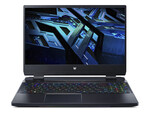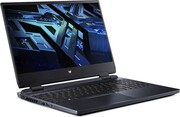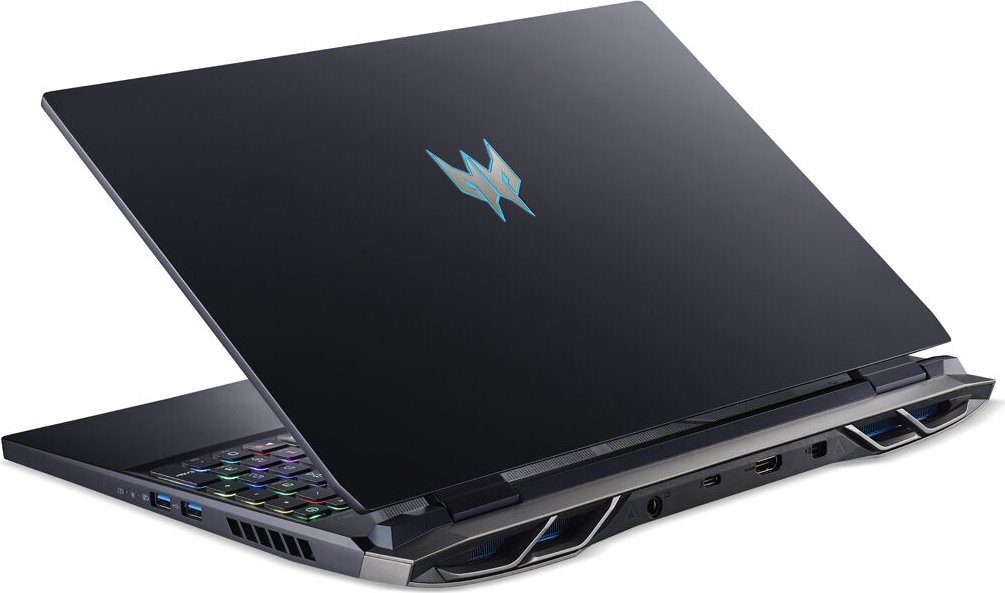Acer Predator Helios 300 PH315-55s-98TX
Spécifications de l'ordinateur portable

Price comparison
Moyenne de 8 notes (à partir de 11 critiques)
Critiques pour le/la Acer Predator Helios 300 PH315-55s-98TX
Source: Cowcotland

Nous sommes confrontés à une nouvelle technologie et cela se voit. De nombreux points doivent être revus avec cette dalle certes bluffante en 3D, et encore plus avec des jeux non compatibles, mais c'est une catastrophe à mettre en place. Nous accumulons les retours au bureau, les freezes et même un BSOD. Surtout, le matériel reste insuffisant pour cette dalle (notons cependant qu'une nouvelle version existe avec un i9-13980HX et une RTX 4080). Et cela est clairement juste pour la 3D, en dehors de cela, nous avons un laptop qui est extrêmement bruyant, lourd et encombrant (passons cependant sur ces deux derniers points étant donné les exigences de la 3D) avec un matériel toujours un peu juste pour de l'UHD. C'est dommage car en dehors de cela, nous avons d'excellentes performances en termes d'applications lourdes comme Adobe Premiere, et la dalle est vraiment bien calibrée en usine.
Critique simple, disponibles en ligne, Très longue, Date: 08/10/2023
Critiques dans des langues étrangères
Source: Tom's Guide
 EN→FR
EN→FRThe Acer Predator Helios 300 Spatial Labs is a gaming powerhouse. If you want to experience demanding modern games at 4K / 60 fps with minimal compromise to settings, this is the laptop for you. As an all-rounder, though, it’s hard to fully get behind the Helios. Though it posts strong numbers during our productivity tests, design flaws hamper this laptop’s ability to cement itself as a great all-rounder. Weight, noise and heat issues mean this Acer essentially eliminates itself from easy day-to-day usage before you factor in a single performance metric. This is one of the least subtle laptops I’ve ever seen, and I both admire and resent that about the Helios. If you’re serious about PC gaming — and have money to burn — the allure of this machine’s specs is strong. At the same time, I can’t help but feel your money would be better spent elsewhere.
Critique simple, disponibles en ligne, Longue, Date: 06/21/2023
Notes: Note globale: 60%
Source: PC Mag
 EN→FR
EN→FRThe Acer Predator Helios 300 Spatial Labs Edition has an entertaining party trick in its glasses-free 3D display, but it falls behind competitors that kick it to the curb at every corner. Worse still, the 3D entails a lot of sacrifices, particularly from the screen, including brightness and refresh rate, and still feels like hardly anything more than a novelty. For more than $3,000, you can do a lot better. For less than $3,000, you can still do better, and that’s what makes it hard to confidently recommend this machine. Start with a performance grinder like the Lenovo Legion Pro 7i Gen 8, and save a bundle. too.
Critique simple, disponibles en ligne, Longue, Date: 05/23/2023
Notes: Note globale: 50%
Source: PC World
 EN→FR
EN→FRWhile the guts of the Predator Helios 300 SpatialLabs Edition are pretty solid, the entire system is let down by its screen. The tech works, but if you’re into gaming on the go, this expensive package is a disappointment. I’d say even with the upcoming 13th gen Intel/Nvidia 40-series refresh of this product, having a limited 60Hz panel makes it a tough recommendation. When similar gaming laptops are reaching 240Hz and beyond, 60Hz even at 4K seems pretty wimpy. More than that, the inconsistent 3D implementation dulls the sharpness of the slow panel. For its $3,500 price, you really need to want the glasses-free 3D screen, and will need to be into any genre but fast-twitch shooters or e-sports titles that benefit from the responsiveness of a high-refresh screen. That’s a lot of caveats. I’ll admit that when the 3D effect works, it can be utterly enchanting. And there may be interesting applications of this technology—if they can get the refresh rate up in future SpatialLabs screens, then the premium might be worth it for gamers.
Critique simple, disponibles en ligne, Longue, Date: 05/09/2023
Notes: Note globale: 50%
Source: Slashgear
 EN→FR
EN→FRSo should you give this laptop any consideration next time you're hunting for a gaming computer? The answer is yes only if you have bottomless pockets and an itch to try out novelties. Truthfully, if I owned this laptop, I would use the 3D function maybe 10% of the time. At that rate, there are laptops that deliver just as much, or almost as much, power as the Helios but for half the cost. Consider, for example, the Acer Nitro 5. This laptop offers a 17-inch, 144 Hz display and, while it uses the (marginally) less powerful RTX 3060 graphics chip, it also costs less than $800. To get closer to a higher-end laptop, there's the $2,500 Razer Blade 15 Advanced Model, with an RTX 3070 GPU card that closely competes with the GPU in the Predator. You also get a luxe 240Hz QHD picture, for $1,000 less than this Helios. You'll find the Acer Predator Helios 300 SpatialLabs Edition available at B&H Photo for around $3,500. While I enjoyed playing on this laptop with the 3D function switched off, this simply wouldn't be a feature I'm willing to pay for. Especially if you frequent the indie side of games, where there will almost certainly be no 3D compatibility development, you'll mostly find the glasses-free 3D to be a flashy novelty. And even in an era where we're pursuing the latest and greatest in immersive gaming experiences, glasses-free 3D is a tough sell when there's so much for VR on the market.
Critique simple, disponibles en ligne, De taille moyenne, Date: 04/19/2023
Notes: Note globale: 60%
Source: Expert Reviews
 EN→FR
EN→FRThe SpatialLabs 3D technology showcased by the Acer Predator Helios 300 is undoubtedly very impressive and it’s clearly heading in the right direction. The effect is incredibly immersive given the right game, and even with the inherent drawbacks such as having to keep your head still, it’s great fun to game with. Right now, though, I’m not convinced there are enough compelling 3D Ultra-compatible games to justify the cost. Perhaps if the Helios 300 didn’t cost so much more than an equivalent non-SpatialLabs gaming machine I could make a solid case for considering it. However, when all is said and done, I still can’t quite shake the feeling that this is a technology demonstrator and that it would be wiser to wait for the next-generation model with an RTX40-series GPU and maybe even a higher native refresh rate.
Critique simple, disponibles en ligne, Très longue, Date: 04/12/2023
Notes: Note globale: 80%
Source: Engadget
 EN→FR
EN→FRIf, for some reason, glasses-free 3D is still compelling to you, there are few other options. Acer also sells a standalone 15.6-inch SpatialLabs screen for $1,100 – but I don't need to tell you that's a bad idea. The company's ConceptD 7 laptop also had that screen, but it’s no longer available. There's also ASUS's upcoming spin on glasses-free 3D with its ProArt StudioBook 16, which looked compelling during our CES preview. Barring a miraculous advancement in holographics sometime soon, I'm ready to give up on the entire notion of glasses-free 3D. It just doesn’t make sense to spend $3,500 on the Helios 300 SpatialLabs Edition. While there's a chance the technology could eventually help a certain subsection of professionals, those folks would likely be served better with VR headsets, and potentially AR devices like the Magic Leap 2 in the future. Either option would deliver a better dose of 3D without the headaches of glasses-free tech.
Critique simple, disponibles en ligne, De taille moyenne, Date: 03/27/2023
Notes: Note globale: 59%
Source: Gamestar
 DE→FR
DE→FRCritique simple, disponibles en ligne, Longue, Date: 03/30/2023
Notes: Note globale: 90%
Source: Geeknetic
 ES→FR
ES→FRCritique simple, disponibles en ligne, Très longue, Date: 03/04/2023
Notes: Note globale: 80%
Source: Noticias 3D
 ES→FR
ES→FRCritique simple, disponibles en ligne, Très longue, Date: 12/21/2022
Source: Quotidiano Hardware Upgrade
 IT→FR
IT→FRCritique simple, disponibles en ligne, Longue, Date: 05/08/2023
Commentaire
NVIDIA GeForce RTX 3080 Laptop GPU:
Carte graphique haut de gamme pour ordinateur portable basée sur la puce Ampere GA104. Au moment de son lancement, début 2021, la 3080 est la carte graphique pour ordinateur portable la plus rapide du marché.
Ces cartes graphiques de milieu de gamme peuvent faire tourner tout les jeux récents de façon fluide. Les jeux gourmands ne peuvent être joués qu'avec les détails réglés sur moyen.
>> Plus d'informations sont à trouver dans notre comparaison des cartes graphiques mobiles et ainsi que dans notre liste des Benchmarks affiliés.
i9-12900H:
Un processeur mobile basé sur Alder-Lake avec 6 cœurs de performance et 8 cœurs efficaces. Les cœurs de performance offrent un hyper threading, ce qui permet de traiter 20 threads. Le processeur fonctionne à des fréquences allant de 1,8 à 5 GHz et prend en charge vPro.
>> Plus d'informations sont à trouver dans notre comparaison des processeurs mobiles.





